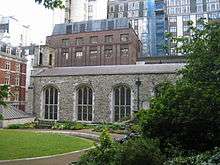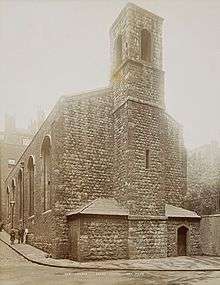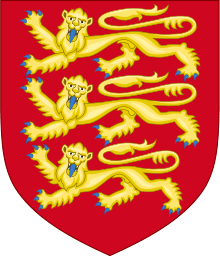Savoy Chapel
| Queen's Chapel of the Savoy | |
|---|---|
 | |
 Queen's Chapel of the Savoy | |
| 51°30′38″N 0°07′12″W / 51.5105°N 0.1199°WCoordinates: 51°30′38″N 0°07′12″W / 51.5105°N 0.1199°W | |
| Country | United Kingdom |
| Denomination | Church of England |
| Previous denomination |
Lutheranism Roman Catholic |
| Website |
royalchapelsavoy |
| History | |
| Status | Royal Peculiar |
| Architecture | |
| Functional status | Active |
| Architect(s) | Richard Griffiths Architects (renovations)[1] |
| Style | Tudor; Perpendicular |
| Completed | 1512 |
| Specifications | |
| Length | Nave: 200 ft (61 m) |
| Number of towers | 1 |
| Materials | Stone |
| Administration | |
| Diocese | London (location) |
| Province | Canterbury |
| Clergy | |
| Chaplain(s) | Rev. Canon Prof. Peter John Galloway OBE |
| Laity | |
| Director of music | Philip Berg MVO |
| Organist(s) | Justin Luke |
Listed Building – Grade II* | |
| Official name: Savoy Chapel (Queen's Chapel of the Savoy) | |
| Designated | 24 February 1958 |
| Reference no. | 1264731[2] |
The Queen's Chapel of St John the Baptist in the Precinct of the Savoy, or the Queen's Chapel of the Savoy, is a church dedicated to St John the Baptist, located just south of the Strand, London, next to the Savoy Hotel.
It sits on the site of the Savoy Palace, once owned by John of Gaunt, that was destroyed in the Peasants Revolt of 1382. Work was begun on the building in 1502 by King Henry VII and it received its first charter to operate as a hospital foundation in 1512 to look after 100 poor and needy men of London. The hospital had fallen into ruin by the late 18th century; only the chapel survived the consequent demolition, which enabled the construction of an approach road at the north of first Waterloo Bridge.
The chapel is owned by the Duchy of Lancaster and as such is a royal peculiar, not being under the jurisdiction of a bishop, but under that of the reigning monarch. It is designated as a Grade II* listed building.[2]
History

The chapel was founded as part of Peter of Savoy's palace which was destroyed during the Peasants' Revolt of 1381. The present chapel building commenced in the 1490s (being completed in 1512) by Henry VII as a side chapel off the Savoy Hospital's 200-foot (61 m) long nave (the nave was secular rather than sacred, held 100 beds and was demolished in the 19th century).
The Savoy Chapel has hosted various other congregations, most notably that of St Mary-le-Strand whilst it had no church building of its own (1549–1714). Also the German Lutheran congregation of Westminster (now at Sandwich Street and Thanet Street, near St Pancras[3]) was granted royal permission to worship in the chapel when it separated from Holy Trinity (the City of London Lutheran congregation now at St Mary-at-Hill).[4] The new congregation's first pastor, Irenaeus Crusius (previously an associate at Holy Trinity), dedicated the chapel on the 19th Sunday after Trinity 1694 as the Marienkirche or the German Church of St Mary-le-Savoy. Archibald Cameron of Lochiel, the last Jacobite leader to be executed for treason, was buried there in 1753.
An Anglican place of worship, the chapel was noted in the 18th and 19th centuries as a place where marriages without banns might occur outside of the usual parameters of ecclesiastical law of that time.[5] It was referred to in Evelyn Waugh's Brideshead Revisited as "the place where divorced couples got married in those days—a poky little place".[6] In 1755 Joseph Vernon married Jane Poitier here and the curate and vicar were transported for fourteen years for carrying out an unlicensed wedding.[7]
In 1908 it was the scene of a suffragette wedding between Victor and Una Duval. The wedding was attended by leading suffragettes and the wedding caused much debate because the bride refused to say "and obey", despite the intervention of the Archbishop of Canterbury.[8]
In 1939, it was announced by the office of the Duchy of Lancaster that the Savoy Chapel would be known as The King's Chapel of the Savoy.
Many of the chapel's stained glass windows were destroyed in the London Blitz during the Second World War. However, a triptych stained glass memorial window survives which depicts a procession of angelic musicians. It is dedicated to the memory of Richard D'Oyly Carte (who was married at the chapel in 1888) and was unveiled by Sir Henry Irving in 1902; after their deaths, the names of Rupert D'Oyly Carte[9] and Dame Bridget D'Oyly Carte were added.[10]
Present


The chapel has been Crown property for centuries as part of the Savoy Hospital estate and remains under the aegis of the monarch as part of the Duchy of Lancaster and thereby is a royal peculiar. The chaplain is appointed by the Duchy (and since 1937 as ex-officio chaplain of the Royal Victorian Order) and effectively it is "parish church" of the Savoy Estate, the Duchy of Lancaster's principal London landholding. Armorial plates commemorating GCVOs past and present are displayed throughout the chapel; the Royal Victorian Order's present Honorary Genealogist is David White, Somerset Herald.
Most of the chapel's costs and maintenance are met by the Duchy of Lancaster, with recent works including landscaping of its garden in honour of the Golden Jubilee of Queen Elizabeth II in 2002 and restoration of the chapel ceiling in 1999. The chapel was further refurbished and a new stained-glass window commemorating the Diamond Jubilee of Queen Elizabeth II was unveiled by the Queen in November 2012.
The Savoy Chapel uses the 1662 Book of Common Prayer and the King James Bible for worship. Services are held each Sunday, to which members of the public are welcomed, excepting occasional special events.[11] The chapel is open for visitors from Monday to Thursday.[12]
Music
Organ
The Chapel possesses a three-manual pipe organ, constructed to the specifications of the previous Master of the Music, William Cole and manufactured by J. W. Walker & Sons Ltd. The organ casework was designed by Arthur Bedford Knapp-Fisher (1888-1965). It was dedicated by Her Majesty The Queen at a service to commemorate the 700th anniversary of the Duchy of Lancaster on 27 October 1965.[13]
Organists
The current Master of the Music is Philip Berg (since 1995); the sub-organist is Justin Luke (since 2002). Previous Masters of the Music include Henry Bromley Derry (from c 1913 to 1954) and William Cole (from 1954 to 1994).
Choir
The choir is rooted in the English cathedral tradition, and consists of up to 21 boy choristers (aged ten upwards) and six professional gentlemen. The trebles are drawn exclusively from St. Olave's Grammar School. Each year up to four prospective year six pupils are selected to sing as trebles in the choir (after passing an academic and vocal test), with their place at St. Olave's confirmed for the following year. Some choristers also join in year 7, during their first year at St. Olave's. Chorister are expected to stay in the choir until their voices break and will attend rehearsals three times a week at school and once a week at the chapel itself. The boy trebles are known as Wakeman choristers in recognition of the 49 years of association that the late Michael Wakeham had with the Choir.[14] The choir sings weekly Sunday morning services of either Eucharist or Matins, as well as those on Christmas and Easter Day. They also sing for various weddings, carol services and royal events throughout the year.[15]
Notes
| Wikimedia Commons has media related to Savoy Chapel (London). |
- ↑ www.rgarchitects.com
- 1 2 Historic England. "Details from listed building database (1264731)". National Heritage List for England. Retrieved 10 November 2016.
- ↑ Lutheran.org
- ↑ http://www.stanneslutheranchurch.org.uk
- ↑ Newgate Records
- ↑ "Brideshead Revisited"
- ↑ A Collection of the Most Remarkable and Interesting Trials: Particularly of Those Persons who Have Forfeited Their Lives to the Injured Laws of Their Country. R. Snagg. 1776. pp. 653–655.
- ↑ Diane Atkinson (8 February 2018). Rise Up Women!: The Remarkable Lives of the Suffragettes. Bloomsbury Publishing. p. 129. ISBN 978-1-4088-4406-9.
- ↑ www.doylycarte.org.uk
- ↑ Goodman, Andrew. Gilbert and Sullivan's London (1988; 2000) Faber & Faber ISBN 0-571-20016-8
- ↑ www.royalchapelsavoy.org
- ↑ Savoy Chapel official website
- ↑ http://royalchapelsavoy.org/music/organ/
- ↑ http://saintolaves.net/wakehamoverview
- ↑ http://royalchapelsavoy.org/music/joining-the-choir/